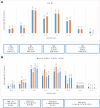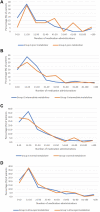Sub-Analysis of CYP-GUIDES Data: Assessing the Prevalence and Impact of Drug-Gene Interactions in an Ethnically Diverse Cohort of Depressed Individuals
- PMID: 35496293
- PMCID: PMC9039251
- DOI: 10.3389/fphar.2022.884213
Sub-Analysis of CYP-GUIDES Data: Assessing the Prevalence and Impact of Drug-Gene Interactions in an Ethnically Diverse Cohort of Depressed Individuals
Abstract
Introduction: Minority groups are underrepresented in pharmacogenomics (PGx) research. Recent sub-analysis of CYP-GUIDES showed reduced length of stay (LOS) in depressed patients with CYP2D6 sub-functional status. Our primary objective was to determine whether PGx guided (G) versus standard treatment (S) influenced LOS among different race/ethnic groups. Secondary objectives included prevalence of drug-gene interactions (DGIs) and readmission rates (RAR). Methods: Retrospective sub-analysis of CYP-GUIDES data comprising CYP2D6 phenotypes was reclassified using standardized CYP2D6 genotype to phenotype recommendations from the Clinical Pharmacogenetics Implementation Consortium (CPIC) and Dutch Pharmacogenetics Working Group (DPWG). The Mann-Whitney test was used to determine differences in LOS between groups G and S and Kruskal Wallis test to compare LOS among different race/ethnic groups. Logistic regression was used to determine covariates associated with RAR. Results: This study included 1,459 patients with 67.3% in G group (n = 982). The majority of patients were White (57.5%), followed by Latinos (25.6%) and Blacks (12.3%). Although there were no differences in LOS between G and S groups, Latinos had significant shorter LOS than Whites (p = 0.002). LOS was significantly reduced by 5.6 days in poor metabolizers in group G compared to S (p = 0.002). The proportion of supra functional and ultra-rapid metabolizers (UMs) were 6 and 20.3% using CYP-GUIDES and CPIC/DPWG definitions, respectively. Prevalence of DGIs was 40% with significantly fewer DGIs in Blacks (p < 0.001). Race/ethnicity was significantly associated with RAR (aOR 1.30; p = 0.003). Conclusion: A greater number of patients were classified as CYP2D6 UMs using CPIC/DPWG definitions as compared to CYP-GUIDES definitions. This finding may have clinical implications for using psychotropics metabolized by CYP2D6.
Keywords: CYP2D6 phenotype; depression; drug-gene interactions; ethnicity; length of stay; race.
Copyright © 2022 Crutchley and Keuler.
Conflict of interest statement
The authors declare that the research was conducted in the absence of any commercial or financial relationships that could be construed as a potential conflict of interest.
Figures


Similar articles
-
Results of the CYP-GUIDES randomized controlled trial: Total cohort and primary endpoints.Contemp Clin Trials. 2020 Feb;89:105910. doi: 10.1016/j.cct.2019.105910. Epub 2019 Dec 12. Contemp Clin Trials. 2020. PMID: 31838256 Clinical Trial.
-
Subanalysis of the CYP-GUIDES Trial: CYP2D6 Functional Stratification and Operational Timeline Selection.Psychiatry Res. 2021 Mar;297:113571. doi: 10.1016/j.psychres.2020.113571. Epub 2020 Nov 15. Psychiatry Res. 2021. PMID: 33513485 Clinical Trial.
-
Discrepancies and similarities in the genome-informed guidance for psychiatric disorders amongst different regulatory bodies and research consortia using next generation sequencing-based clinical pharmacogenomics data.Pharmacol Res. 2021 May;167:105538. doi: 10.1016/j.phrs.2021.105538. Epub 2021 Mar 9. Pharmacol Res. 2021. PMID: 33705851
-
Pharmacogenetics Guidelines: Overview and Comparison of the DPWG, CPIC, CPNDS, and RNPGx Guidelines.Front Pharmacol. 2021 Jan 25;11:595219. doi: 10.3389/fphar.2020.595219. eCollection 2020. Front Pharmacol. 2021. PMID: 33568995 Free PMC article. Review.
-
Polymorphism of human cytochrome P450 2D6 and its clinical significance: Part I.Clin Pharmacokinet. 2009;48(11):689-723. doi: 10.2165/11318030-000000000-00000. Clin Pharmacokinet. 2009. PMID: 19817501 Review.
Cited by
-
CYP2D6 and CYP2C19 Variant Coverage of Commercial Antidepressant Pharmacogenomic Testing Panels Available in Victoria, Australia.Genes (Basel). 2023 Oct 16;14(10):1945. doi: 10.3390/genes14101945. Genes (Basel). 2023. PMID: 37895294 Free PMC article.
-
A Bibliometric and Visual Analysis of Single Nucleotide Polymorphism Studies in Depression.Curr Neuropharmacol. 2024;22(2):302-322. doi: 10.2174/1570159X21666230815125430. Curr Neuropharmacol. 2024. PMID: 37581520 Free PMC article.
References
-
- American Psychiatric Assocation (2021). Mental Health Facts for Hispanics and Latinos. AvaliableAt: https://www.psychiatry.org/psychiatrists/cultural-competency/education/m... (Accessed October 28, 2021).
-
- Bradley P., Shiekh M., Mehra V., Vrbicky K., Layle S., Olson M. C., et al. (2018). Improved Efficacy with Targeted Pharmacogenetic-Guided Treatment of Patients with Depression and Anxiety: A Randomized Clinical Trial Demonstrating Clinical Utility. J. Psychiatr. Res. 96, 100–107. 10.1016/j.jpsychires.2017.09.024 - DOI - PubMed
LinkOut - more resources
Full Text Sources

